In October 1848, a small group of Chicagoans witnessed the Pioneer locomotive’s inaugural run as it pulled from the city’s first railway station. CHM director of exhibitions Paul Durica writes about the winding journey it took to find its way to the Chicago History Museum.
The Pioneer locomotive endures as the historical artifact that could. Despite often being overshadowed by larger and more dynamic objects, it has managed to appear (with some modifications to its appearance over the years) at every significant Chicago fair and festival from the 1880s through the 1940s, including both the 1893 World’s Columbian Exposition and the 1933–34 A Century of Progress International Exposition, before finding its forever home at the Chicago History Museum.
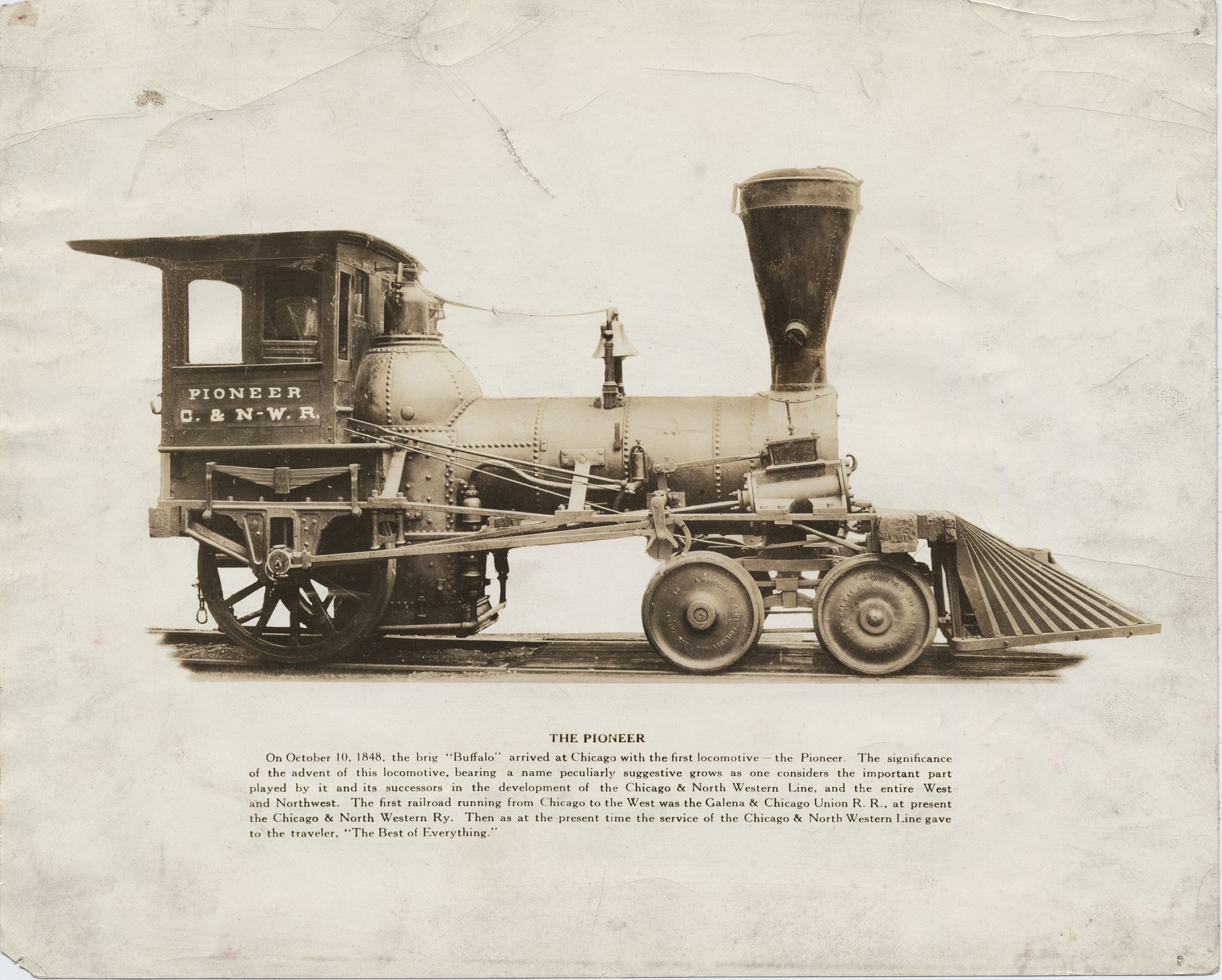
An undated photograph of the Pioneer. The first sentence of the caption reads: “On October 10, 1848, the brig ‘Buffalo’ arrived at Chicago with the first locomotive—the Pioneer.” CHM, ICHi-037010
As the first locomotive to operate within the city, the Pioneer has long remained, in the words of one commentator, the “historic symbol of the coming of the railroads” to Chicago and the nation, transforming both in challenging and enduring ways. A small group of Chicagoans witnessed the Pioneer on its inaugural run as it pulled from the city’s first railway station, near the intersection of present-day Canal and Kinzie Streets, 175 years ago this October. Whether they regarded what they witnessed with optimism, skepticism, or some mix of the two was not recorded.
That first ride on the rails of the still-under-construction Galena and Chicago Union Railroad stretched as far as Des Plaines, Illinois, transporting a group of prominent citizens one way and the same group along with some grain, back to Chicago. Bought second-hand (though with no bill of sale, the origin of the Pioneer remains unknown; it was likely manufactured c. 1840 for an eastern railroad company), the Pioneer was replaced within a decade by bigger, faster, more powerful locomotives as first the Galena and Chicago Union and then other railroad lines expanded throughout the 1850s. As the Chicago Tribune described that first run a century later, this “little event in October 1848. . . was the forerunner of a mighty development that ultimately made Chicago the greatest railroad center in the world.”
In 1883 Chicago celebrated being the “center” of the railroad industry by hosting the National Exposition of Railway Appliances. One of the featured exhibits was the Pioneer, which had from about 1858 to 1874 been used solely for company and construction work and was now deteriorating in a train yard. Given a fresh coat of paint, its significance supported by the memories of retired engineers, the Pioneer had pride of place at the Exposition, but this was a prelude to the exposure it soon received at one of the most significant events in Chicago history.
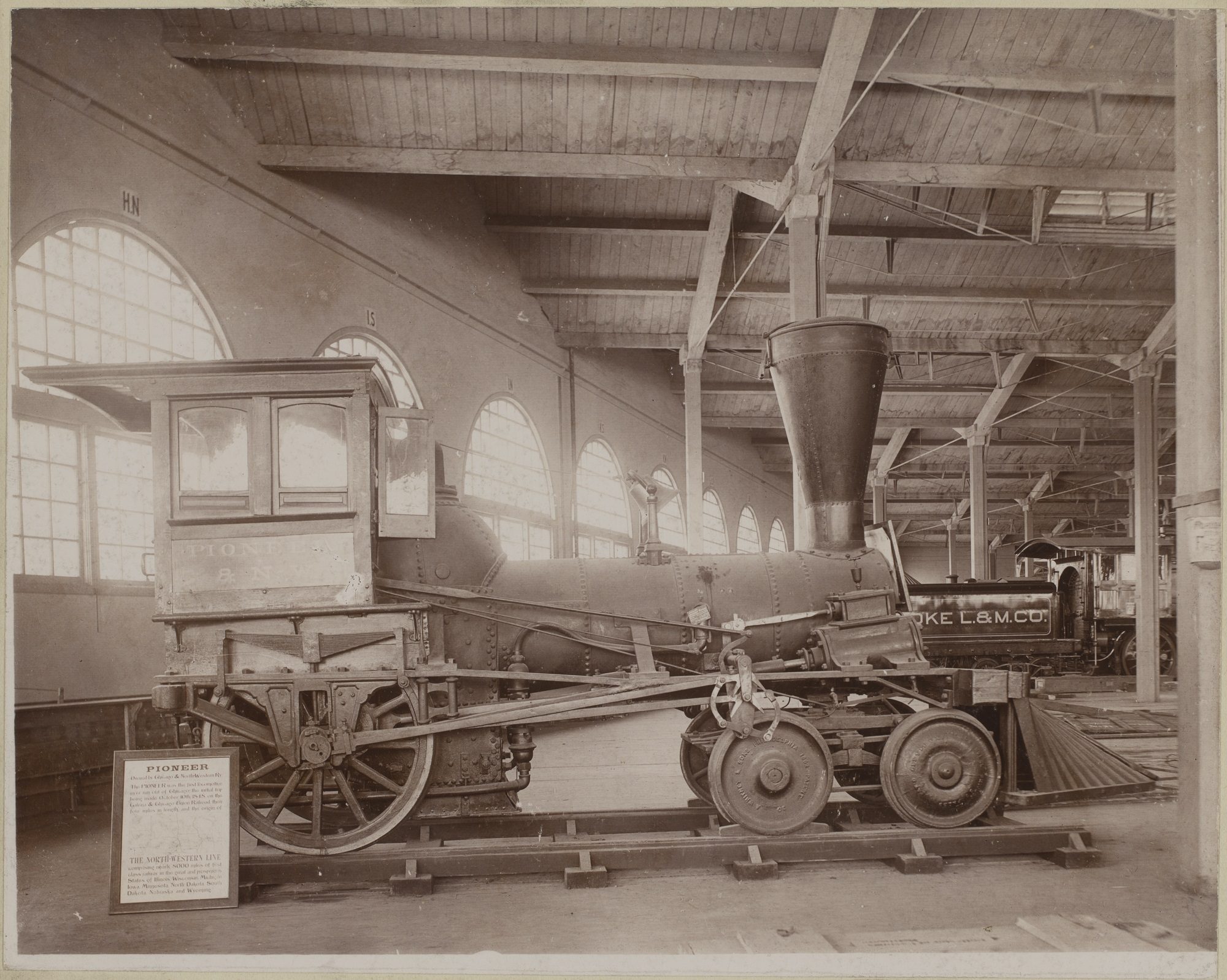
The Pioneer on display in the Transportation Building at the World’s Columbian Exposition, Chicago, 1893. CHM, ICHi-050434
This year marks the 130th anniversary of the World’s Columbian Exposition, the first Chicago world’s fair, an event invested in celebrating the past even as it looked toward the coming twentieth century. At the fair, in the Transportation Building designed by Louis Sullivan, the only one among the fourteen main structures not inspired by the classical past, stood that relic of Chicago, the Pioneer, “a funny-looking contrivance as compared with the great locomotives now in use,” according to the Tribune. There to tell its story was John Ebbert, who claimed to be its first engineer as well as an eyewitness to its arrival via the Great Lakes on the brig Buffalo. Ebbert’s stories of the early days of rail entertained visitors from around the world and established the Pioneer as an important symbol of this history. Today a variation of this experience at the World’s Columbian Exposition survives in an interactive display in the Museum’s Chicago: Crossroads of America exhibition.
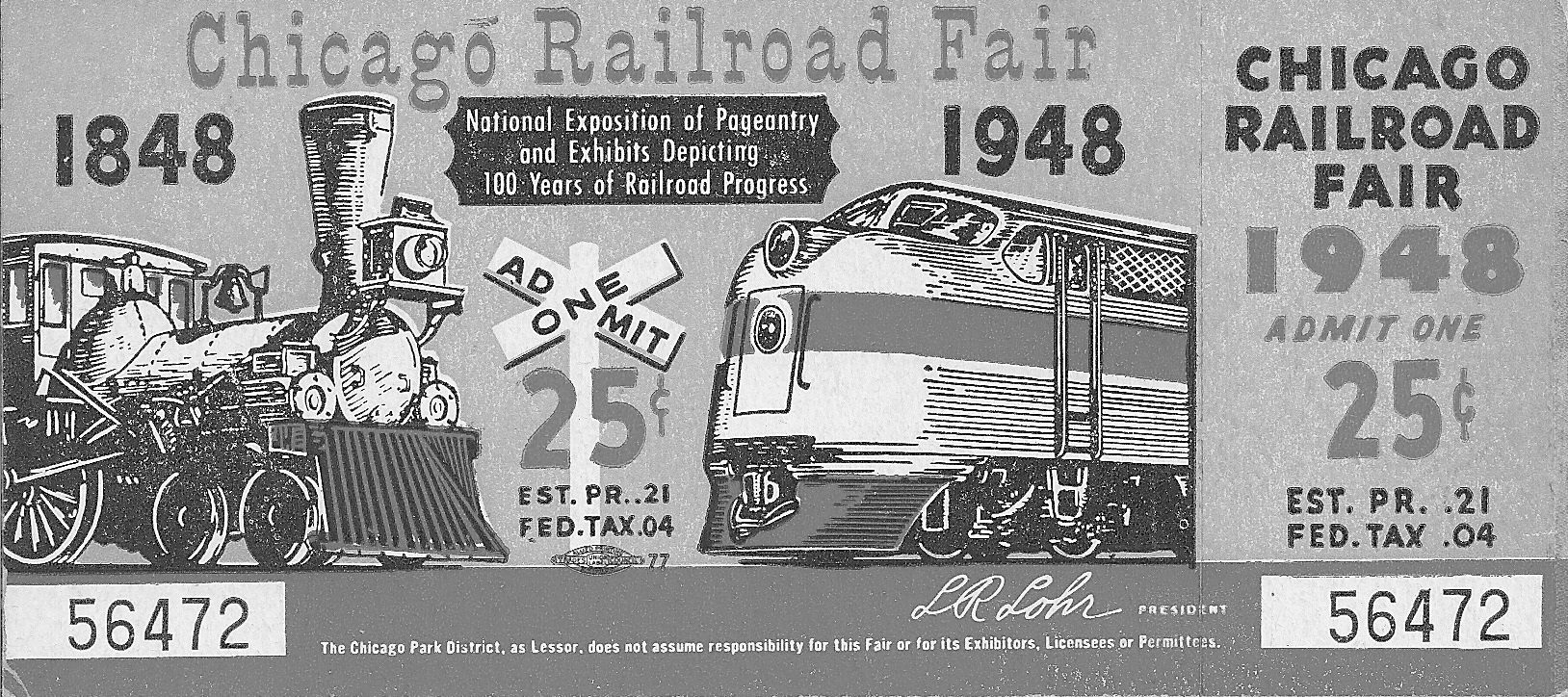
An admission ticket to the 1948 Chicago Railroad Fair. According to the US Bureau of Labor Statistics inflation calculator, 25¢ in 1948 is equivalent to $3.15 in 2023. Courtesy of Joseph M. Di Cola.
From the World’s Columbian Exposition, the Pioneer embarked on a long, winding journey that would take it, among other places, to the Columbian Museum (today’s Field Museum), the 1904 Louisiana Purchase Exposition in St. Louis, A Century of Progress world’s fair, the Museum of Science and Industry, and the 1948 Chicago Railroad Fair.
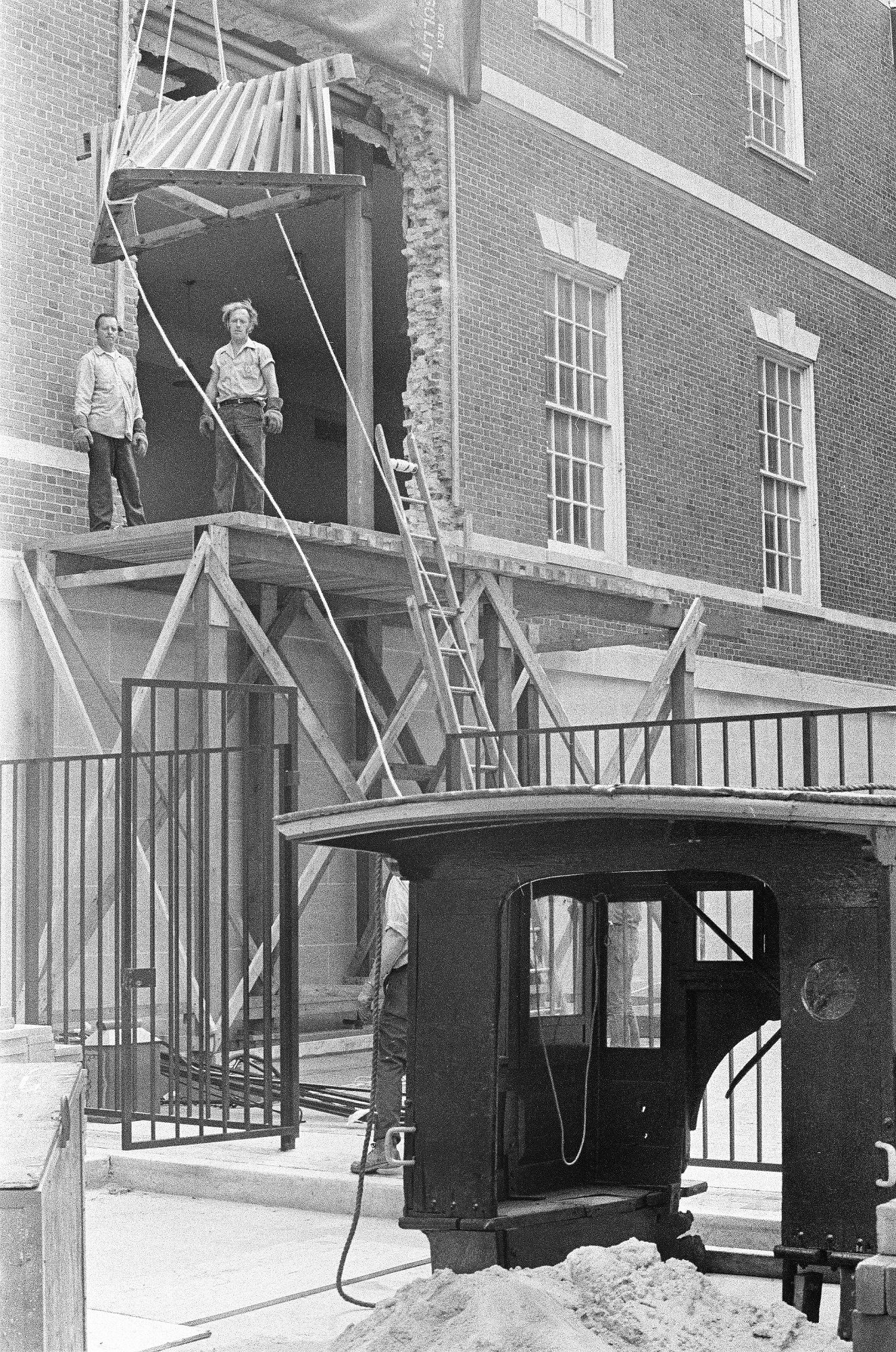
The cowcatcher of the Pioneer being lifted into the Chicago Historical Society (Chicago History Museum), August 15, 1972. ST-19031875-0010, Chicago Sun-Times collection, CHM
It wouldn’t arrive at the Chicago Historical Society until 1972 and would, along with the 1892 L Car, become one of two large artifacts in Chicago: Crossroads of America when it opened in 2006.
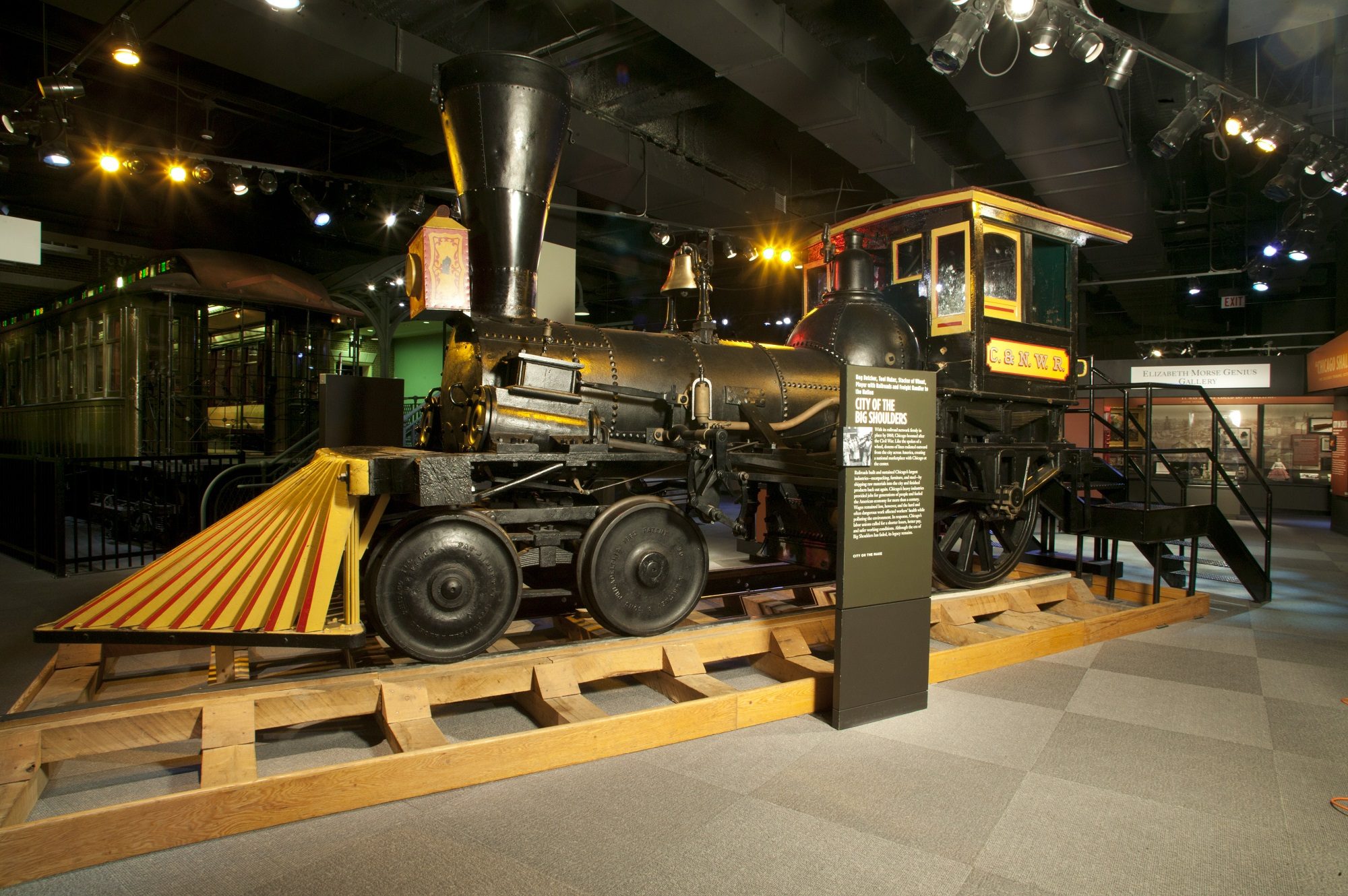
The Pioneer on display in Chicago: Crossroads of America.
There’s one small problem with this whole long story: the Pioneer visitors know may not have pioneered anything. The Pioneer isn’t named in any documents until 1856, when it appears in a Galena and Chicago Union inventory, and there were other locomotives in the company’s stock that fit the description of the one that first left the station in October 1848 (the exact date of which is somewhat disputed by historians). The Pioneer’s history rests solely upon the reminisces of old railroad workers, first taken down in the 1880s and 1890s. “A bill of sale, a contemporary newspaper story, an old diary entry, any scrap dating back to October 1848 might settle the question,” writes John H. White in his survey of the documentary evidence surrounding the Pioneer from 1976. “Perhaps some industrious scholar will one day find the missing information.”
But perhaps having witnessed so much of the city’s history in the last 175 years, where this humble locomotive began its journey and whether it was the first really doesn’t matter anymore?
Sources
- “All Are of Interest: Exhibits to Be Seen in the Transportation Building,” Chicago Daily Tribune, April 30, 1893.
- Paul Angle, “Chicago’s First Railroad,” Chicago History, vol. 1, no. 12 (Summer 1948).
- Philip Hampson, “Chicago Railroad Fair Opens Today,” Chicago Daily Tribune, July 20, 1948.
- Patrick McLear, “The Galena and Chicago Union Railroad: A Symbol of Chicago’s Economic Maturity,” Journal of the Illinois State Historical Society, vol. 73, no. 1 (Spring 1980).
- John H. White Jr., The Pioneer: Chicago’s First Locomotive (Chicago: Chicago Historical Society, 1976).